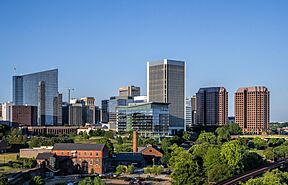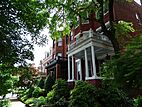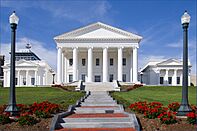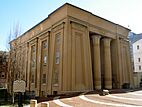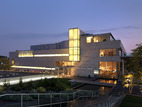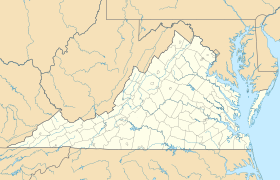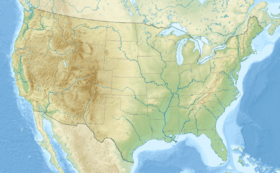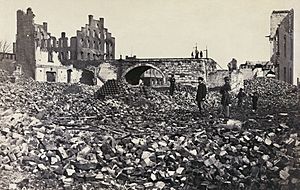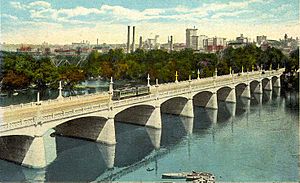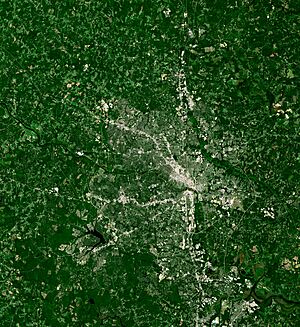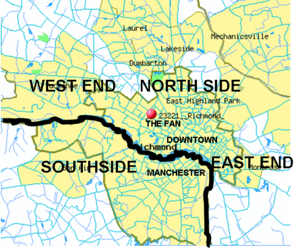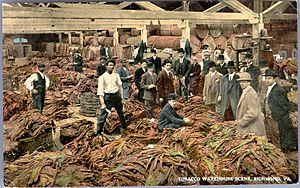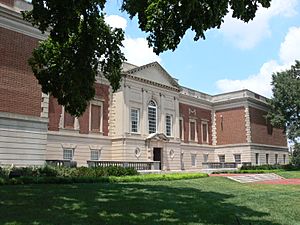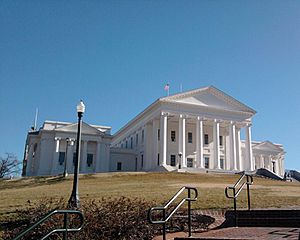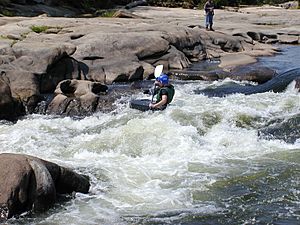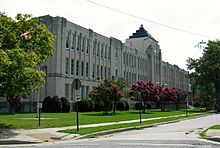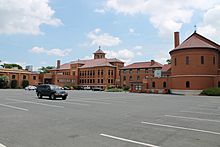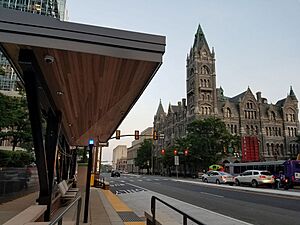Richmond, Virginia facts for kids
Quick facts for kids
Richmond
|
|||
|---|---|---|---|
|
|||
| Nickname(s):
"RVA", "River City"
|
|||
| Motto(s):
Latin: Sic Itur Ad Astra
(Thus do we reach the stars) |
|||
| Country | United States | ||
| State | Virginia | ||
| Incorporated | 1742 | ||
| Named for | Richmond, London | ||
| Area | |||
| • City | 62.57 sq mi (162.05 km2) | ||
| • Land | 59.92 sq mi (155.20 km2) | ||
| • Water | 2.65 sq mi (6.85 km2) | ||
| Elevation | 213 ft (65 m) | ||
| Population
(2020)
|
|||
| • City | 226,610 | ||
| • Rank | 100th in the United States 4th in Virginia |
||
| • Density | 3,782/sq mi (1,484.75/km2) | ||
| • Urban | 1,059,150 (US: 44th) | ||
| • Urban density | 2,067.3/sq mi (798.2/km2) | ||
| • Metro | 1,339,182 (US: 44th) | ||
| Demonym(s) | Richmonder | ||
| GDP | |||
| • Metro | 6.960 billion (2023) | ||
| Time zone | UTC−5 (EST) | ||
| • Summer (DST) | UTC−4 (EDT) | ||
| ZIP Codes |
23173, 23218–23242, 23249–23250, 23255, 23260–23261, 23269, 23273–23274, 23276, 23278–23279, 23282, 23284–23286, 23288–23295, 23297–23298
|
||
| Area codes | 804 and 686 | ||
| FIPS code | 51-67000 | ||
| GNIS feature ID | 1499957 | ||
|
1071 to 1501 – Richmond: a castle town in Yorkshire, UK. 1501 to 1742 – Richmond, a palace town in London, UK. 1742 to present – Richmond, Virginia. |
|||
Richmond is the capital city of Virginia in the United States. It became an independent city in 1871. This means it is not part of any county. In 2020, about 226,610 people lived here, making it Virginia's fourth-largest city. The larger Richmond area has over 1.3 million residents.
Richmond is located by the James River, about 44 miles west of Williamsburg. It is also 92 miles south of Washington, D.C.. Major highways like Interstate 95 and Interstate 64 meet here. Nearby counties are Henrico and Chesterfield.
Richmond was once an important village for the Powhatan Confederacy. English settlers from Jamestown lived there briefly in the early 1600s. The city was officially founded in 1737. It became the capital of Virginia in 1780, taking over from Williamsburg.
During the Revolutionary War, important events happened in Richmond. Patrick Henry gave his famous "Give me liberty, or give me death!" speech here. The Virginia Statute for Religious Freedom, written by Thomas Jefferson, was also passed in Richmond.
Later, during the American Civil War, Richmond was the capital of the Confederate States of America. The Jackson Ward neighborhood became a major center for African American businesses and culture. It was even called the "Black Wall Street of America." In the early 1900s, Richmond had one of the world's first successful electric streetcar systems.
Today, Richmond's economy is mainly driven by law, finance, and government. Many important government offices and law firms are in the downtown area. Several large companies, including some on the Fortune 500 list, are also located in the Richmond area.
Contents
History of Richmond
Early Days of Richmond
After the first English settlement in Jamestown, Virginia in 1607, explorers went up the James River. They found an area where Powhatan Native Americans lived.
In 1737, a man named William Byrd II asked Major William Mayo to design the town. Byrd named it "Richmond" because the view of the James River reminded him of the River Thames in Richmond, England. The town was officially started in April 1737 and became a city in 1742.
Revolutionary War and Beyond
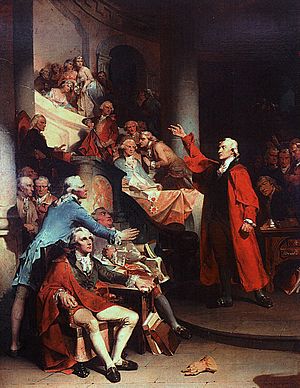
In 1775, Patrick Henry gave his famous "Give me Liberty or Give me Death" speech at St. John's Church. This speech was very important for Virginia's role in the Continental Congress. On April 18, 1780, Richmond became the state capital. This was done to make it more central and safer from British attacks. However, in 1781, British troops led by Benedict Arnold burned Richmond. Governor Thomas Jefferson had to flee.
Richmond quickly rebuilt after the war. By 1782, it was a busy city again. In 1786, the Virginia Statute for Religious Freedom was passed in Richmond. This law, written by Thomas Jefferson, was key for religious freedom in the United States. The Virginia State Capitol building, designed by Thomas Jefferson, was finished in 1788.
After the American Revolutionary War, Richmond became an important industrial city. George Washington helped design a canal to move goods around the James River's rapids. This helped Richmond become a center for manufacturing. It had large iron works and flour mills. In 1848, Henry Box Brown famously escaped slavery by mailing himself in a box from Richmond to Philadelphia.
Richmond During the Civil War
On April 17, 1861, Virginia decided to leave the United States and join the Confederacy. Richmond became the capital of the Confederate States of America. The city was hard to defend but was protected by the Army of Northern Virginia. It became a main target for the Union army.
Richmond had many important things for the Confederacy. It had government offices, hospitals, and a major railroad hub. The Tredegar Iron Works in Richmond was the largest factory in the Confederacy. It made artillery and armor plating for ships, like the CSS Virginia, the world's first ironclad. The Confederate Congress met in the Virginia State Capitol. The "White House of the Confederacy" was also in Richmond.
In 1862, Union General McClellan tried to capture Richmond but failed. Three years later, in March 1865, the Confederate capital could no longer be defended. On April 2, 1865, Confederate leaders left the city. They burned warehouses to keep supplies from the Union army. Union troops entered Richmond and helped stop the fires. About 25% of the city's buildings were destroyed.
President Abraham Lincoln visited Richmond on April 4, 1865. General Robert E. Lee surrendered his army a few days later.
After the Civil War
Richmond quickly recovered after the American Civil War. It became an economic powerhouse again. The city became a major railroad center. Tobacco processing also grew. In 1888, Richmond got the first successful electric trolley system in the United States. This system used overhead wires and helped other cities build their own streetcar systems.
Richmond in the 20th Century
By 1900, Richmond was the most crowded city in the Southern United States. African Americans who were freed from slavery built a strong business community. The Jackson Ward neighborhood became known as the "Wall Street of Black America." In 1903, Maggie L. Walker became the first female bank president in the U.S. She started St. Luke Penny Savings Bank.
In 1910, the city of Manchester joined Richmond. More areas were added in 1914. In 1914, Richmond also became the headquarters for the Fifth District of the Federal Reserve Bank.
Many theaters were built in the 1920s, like the Landmark Theatre. Richmond's first radio station, WRVA, started in 1925. The first TV station south of Washington, D.C., WTVR-TV, was also in Richmond.
From 1963 to 1965, many new buildings were constructed downtown. In 1968, Virginia Commonwealth University was formed. In 1970, Richmond's size grew by 27 square miles. This added over 47,000 people from Chesterfield County to the city. In 1996, a statue of African American tennis star Arthur Ashe was placed on Monument Avenue. This caused some debate, but the statue was completed.
A large flood wall was finished in 1995 to protect Richmond from the James River. This helped businesses grow in the River District. Today, this area has many restaurants and entertainment spots.
Geography of Richmond
Richmond is located at 37.538 degrees North and -77.462 degrees West. The city covers about 62 square miles. Most of this is land, with about 2.7 square miles of water. Richmond is in the Piedmont region of Virginia. This area has low, rolling hills. It is located where the James River becomes deep enough for boats.
The Richmond metropolitan area includes Richmond and several nearby cities and counties. This area has a population of over 1.2 million people. Richmond is about 21 miles north of Petersburg, Virginia and 96 miles south of Washington, D.C..
Areas of Richmond
Richmond's first street plan was made in 1737. It covered the area between Broad, 17th, and 25th Streets and the James River. Modern Downtown Richmond is a bit further west.
- Downtown: This area is on the slopes of Shockoe Hill. Nearby are Shockoe Bottom, a historic low-lying area, and Monroe Ward.
- East End: This includes neighborhoods like Church Hill, which has St. John's Church. It also has poorer areas and public housing projects.
- Central Area: Between Belvidere Street, Interstate 195, Interstate 95, and the river. This area includes Virginia Commonwealth University (VCU). The Fan is an affluent area with Victorian architecture and many students. West of the Fan is the Museum District, home to the Virginia Museum of Fine Arts.
- South of Downtown: This area includes Byrd Park, Maymont, and Hollywood Cemetery. Carytown is a popular shopping area.
- Northside: This area has many historic districts. Neighborhoods like Chestnut Hill-Plateau and Barton Heights grew when streetcars made it easy to travel downtown.
- West End: This is an affluent, suburban area. It includes places like Windsor Farms and the University of Richmond.
- Southside: This part of the city is south of the James River. It has both wealthy areas like Westover Hills and poorer areas like Manchester. Much of Southside used to be part of Chesterfield County.
Richmond's Climate
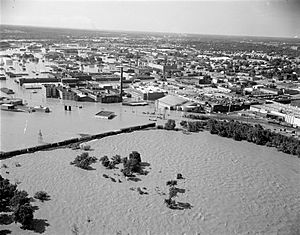
Richmond has a humid subtropical climate. This means it has hot, humid summers and moderately cold winters. The mountains to the west help block very cold air. The nearby Chesapeake Bay and Atlantic Ocean also affect the weather.
The coldest weather is usually from late December to early February. Temperatures rarely drop below 0°F. The hottest weather is in July, with temperatures often reaching 90°F or higher. The highest temperature ever recorded was 107°F in August 1918. The lowest was -12°F in January 1940.
Rainfall is spread out throughout the year. Dry periods can happen, especially in autumn. Snowfall is usually light, averaging about 10.5 inches per year. Snow typically stays on the ground for only a day or two. Ice storms can occur but usually do not cause much damage.
The James River can flood in Richmond, most often in March. Hurricanes and tropical storms cause most floods in summer and early fall. For example, in 2004, Hurricane Gaston caused major flooding downtown.
Population and People
| Historical population | |||
|---|---|---|---|
| Census | Pop. | %± | |
| 1790 | 3,761 | — | |
| 1800 | 5,737 | 52.5% | |
| 1810 | 9,735 | 69.7% | |
| 1820 | 12,067 | 24.0% | |
| 1830 | 16,060 | 33.1% | |
| 1840 | 20,153 | 25.5% | |
| 1850 | 27,570 | 36.8% | |
| 1860 | 37,910 | 37.5% | |
| 1870 | 51,038 | 34.6% | |
| 1880 | 63,600 | 24.6% | |
| 1890 | 81,388 | 28.0% | |
| 1900 | 85,050 | 4.5% | |
| 1910 | 127,628 | 50.1% | |
| 1920 | 171,667 | 34.5% | |
| 1930 | 182,929 | 6.6% | |
| 1940 | 193,042 | 5.5% | |
| 1950 | 230,310 | 19.3% | |
| 1960 | 219,958 | −4.5% | |
| 1970 | 249,621 | 13.5% | |
| 1980 | 219,214 | −12.2% | |
| 1990 | 203,056 | −7.4% | |
| 2000 | 197,790 | −2.6% | |
| 2010 | 204,214 | 3.2% | |
| 2020 | 226,610 | 11.0% | |
| 2022 (est.) | 229,395 | 12.3% | |
| U.S. Decennial Census 1790–1960 1900–1990 1990–2000 2010–2020 |
|||
Richmond's population is about 226,000 people. The larger Richmond area has about 1.3 million residents.
In 2010, about 50.6% of the people in Richmond were Black or African American. About 40.8% were White. Other groups included Asian (2.3%), Native American (0.3%), and Hispanic or Latino (6.3%).
In 2000, the average household income was $31,121. The average family income was $38,348. About 21.4% of the population lived below the poverty line. This included 32.9% of children under 18.
Religions in Richmond
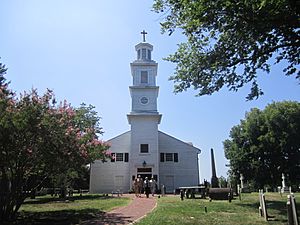
In 1786, the Virginia Statute for Religious Freedom was passed in Richmond. This law, written by Thomas Jefferson, helped create the idea of separating church and state in the U.S. The First Freedom Center now marks this important site.
Richmond has many historic churches. Because of its early English history, there are several important Anglican/Episcopal churches. These include St. John's Episcopal Church, built in 1741. First Baptist Church of Richmond was founded in 1780. Second Presbyterian Church of Richmond, built in 1845, was where Stonewall Jackson attended. St. Peter's Church was the first Catholic church in Richmond, opened in 1834. The Cathedral of the Sacred Heart is the main Catholic church for the area.

The first Jewish group in Richmond was Kahal Kadosh Beth Shalom. It was the sixth Jewish group in the United States. Today, Richmond has several Jewish synagogues and organizations.
Due to German immigrants in the 1840s, St. John's German Evangelical church was formed in 1843. Saints Constantine and Helen Greek Orthodox Cathedral opened in 1917. It is one of two Eastern Orthodox churches in Richmond.
There are seven masjids (mosques) in the Richmond area for the growing Muslim population. The first one was Masjid Bilal.
Hinduism is also practiced in Richmond, especially in the suburbs. There are several Hindu temples and cultural centers.

Richmond has several seminaries (schools for religious studies). These include schools at Virginia Union University and Union Presbyterian Seminary.
Richmond's Economy
Richmond's location on the James River made it a great place for business. It has always been a natural center for trade. Goods could be moved by boats, trains, and cars. Richmond has the world's only triple crossing of rail lines.
Law and finance are very important to Richmond's economy. The city is home to the Virginia Supreme Court. It also has a Federal Reserve Bank, one of only twelve in the country. Many large financial companies have offices here.
Since the 1960s, Richmond has been a major center for advertising. The Martin Agency, a well-known advertising firm, is based here. Virginia Commonwealth University (VCU) has a top graduate advertising school.
Richmond also has a growing biotechnology research park. This park helps new biotechnology and pharmaceutical companies grow. The United Network for Organ Sharing, which manages organ transplants in the U.S., is located here. Philip Morris USA also has a large research facility in the park.
Richmond's downtown area has been revitalized. It includes the Canal Walk and a new convention center. A new performing arts center, Richmond CenterStage, opened in 2009.
The city also has a growing number of craft beer, cider, and liquor producers. There are twelve micro-breweries in the city.
Richmond is becoming a popular place for filming movies and TV shows. Films like Lincoln and TV series like Turn have been filmed here.
Major Companies in Richmond
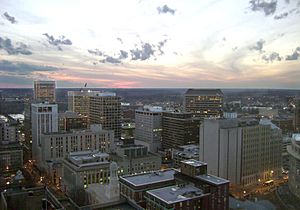
Richmond is a great city for business. In 2007, MarketWatch named it the third-best city for business. The area is home to six Fortune 500 companies. These are very large companies. Dominion Energy is headquartered in the city of Richmond. Other companies like CarMax and Altria Group are in nearby counties.
Other large companies with offices in Richmond include Capital One and McKesson Corporation. DuPont has a production facility here. UPS Freight, a shipping company, also has its main office in Richmond.
Poverty in Richmond
In 2016, about 24.8% of Richmond residents lived below the poverty line. This was the second-highest rate among Virginia's largest cities. A report also found that Richmond had a child poverty rate of 39%. This is more than double the rate for Virginia as a whole. Richmond also had one of the highest rates of eviction filings in the U.S.
Arts and Culture
Museums and Monuments
Richmond has many museums. The Virginia Historical Society and the Virginia Museum of Fine Arts are in the Museum District. The Science Museum of Virginia is in a former train station. Next to it is the Children's Museum of Richmond. Downtown, you can find the Library of Virginia and the Valentine Richmond History Center. The city also has the Virginia Holocaust Museum.
Richmond has several museums and battlefields about the American Civil War. The Richmond National Battlefield Park and the American Civil War Center at Historic Tredegar are by the river. They are in the old Tredegar Iron Works buildings, where many war supplies were made. Near the Virginia State Capitol is the Museum of the Confederacy and the Davis Mansion, also known as the Confederacy's White House.
The city is also working to show the history of slavery and freedom. There is a former slave trail along the river. In 2007, the Reconciliation Statue was placed in Shockoe Bottom. Similar statues are in Liverpool and Benin, representing the Triangle Trade.
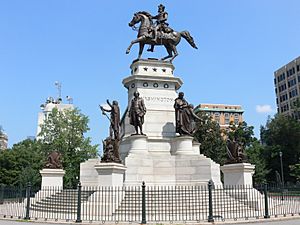
Other interesting historical places include St. John's Church, where Patrick Henry gave his famous speech. The Edgar Allan Poe Museum shows many of his writings and items from his life. The John Marshall House, home of a former Chief Justice, is also downtown. Hollywood Cemetery is where two U.S. Presidents and many Civil War soldiers are buried.
The Virginia Washington Monument was designed by Thomas Crawford. It has a sculpture of George Washington on horseback. The World War I Memorial Carillon, a tower with 56 bells, is near Byrd Park. The Virginia War Memorial honors Virginians who died in various wars.
Agecroft Hall is an old English Tudor manor house. It was moved from England to Richmond and is now on the James River.
Visual and Performing Arts
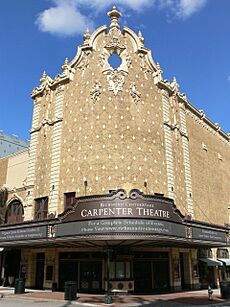
Richmond has a long history of live theater. In the past, famous actors performed here. Today, Richmond has many professional performing arts groups. These include the Virginia Repertory Theatre, Richmond Ballet, Richmond Symphony, and Virginia Opera.
Other places for performances include:
- Altria Theater, a city-owned opera house.
- The Byrd Theatre in Carytown, a movie palace from the 1920s.
- National Theater.
- Dominion Energy Center, which includes the Carpenter Theater.
Richmond has many art galleries. The Visual Arts Center of Richmond and 1708 Gallery are non-profit galleries.
Murals in Richmond
Richmond has over 100 murals. These were created by artists from around the world and local artists. The Richmond Mural Project and the RVA Street Art Festival helped create these murals. In 2020, the Mending Walls Project started. It features murals by pairs of local artists.
Literary Arts
Richmond has always been a place for writers. Edgar Allan Poe grew up here, and his museum is in the city's oldest stone house. Many famous publications started in Richmond, like The Southern Literary Messenger. Other well-known authors from Richmond include Ellen Glasgow and James Branch Cabell. Tom Wolfe was born in Richmond. The creator of Breaking Bad, Vince Gilligan, was also born here.
Architecture of Richmond
Richmond has many important buildings designed by famous architects. The city has many different styles, including Georgian, Greek Revival, and Art Deco.
Much of Richmond's early architecture was destroyed by fire in 1865. However, some buildings from the colonial period still stand. These include the Patteson-Schutte House and parts of the Edgar Allan Poe Museum (Richmond, Virginia).
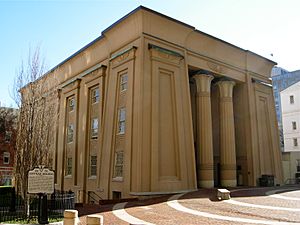
Many buildings in Richmond show classical architecture. The Virginia State Capitol was designed by Thomas Jefferson in 1785. It was the first U.S. government building built in the neo-classical style. This style influenced other government buildings, like the White House. The 1845 Egyptian Building is one of the few Egyptian Revival buildings in the U.S.
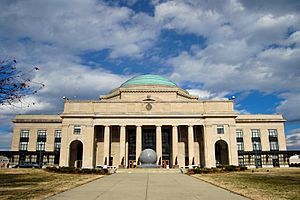
John Russell Pope designed Broad Street Station, which is now the Science Museum of Virginia. The Jefferson Hotel was designed by Carrère and Hastings. Many buildings at the University of Richmond were designed by Ralph Adams Cram.
Richmond's neighborhoods have many unique homes. The Fan, Museum District, and Church Hill have many townhomes. These areas are popular places to live.
Richmond is also known for its Cast-iron architecture. It has many cast iron porches, balconies, and fences. This was because Richmond was a center for iron production.
Modern architecture is also present in Richmond. Minoru Yamasaki designed the Federal Reserve Building. Philip Johnson designed the WRVA Building. The Richard Neutra-designed Rice House is Richmond's only true International Style home.
Historic Districts
Richmond has 45 historic districts. These districts protect the city's history, architecture, and culture. Most of these districts are also listed on the National Register of Historic Places.
Some of the larger historic districts include:
- Boulevard
- Broad Street
- Chimborazo Park
- Church Hill North
- Jackson Ward
- Monument Avenue
- Shockoe Slip
- Shockoe Valley

Many individual buildings are also designated as historic districts, such as:
- The Barret House
- Bolling Haxall House
- Jefferson Hotel
- John Marshall House
- Old Stone House (part of the Edgar Allan Poe Museum (Richmond, Virginia))
- St. Paul's Episcopal Church
- White House of the Confederacy
Food Scene
Richmond is known as a "foodie city." It is especially famous for its modern versions of traditional Southern cuisine. The city also claims to have invented the sailor sandwich. In 1935, canned beer was first sold commercially in Richmond.
Sports in Richmond
Richmond does not have a major professional sports team. However, the Washington Commanders football team holds its summer training camp here. The city has several minor league sports teams. These include the Richmond Kickers (soccer) and the Richmond Flying Squirrels (baseball). The Kickers started playing in Richmond in 1993. The Squirrels began playing in 2010.
Richmond is also home to the Richmond Black Widows, a women's football team.
The Arthur Ashe Athletic Center is a large sports venue. It is named after tennis star Arthur Ashe, who was from Richmond. In 2010, Richmond was named the third "Best Tennis Town" in the U.S.
Richmond hosted the 2015 UCI Road World Championships, a major cycling event. Cyclists from 76 countries competed. This event brought a lot of money to the Richmond area.
The University of Richmond football team won the 2008 NCAA Division I FCS National Championship. The Richmond Spiders and VCU Rams college basketball teams also have had success.
Parks and Recreation
Richmond has one of the oldest city park systems in the country. In 1851, the city bought land for Monroe Park. Today, Richmond has over 40 parks covering more than 1,500 acres.
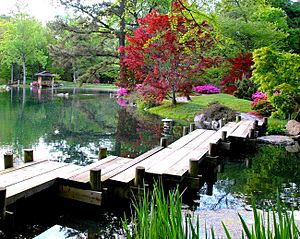
Other city parks include Joseph Bryan Park Azalea Garden and Forest Hill Park.
James River Parks
Many of Richmond's parks are along the James River. These are part of the James River Parks System. They offer bike trails, hiking trails, and scenic views.
There are parks on two main islands in the James River: Belle Isle and Brown's Island. Belle Isle was once a Native American fishing village and a Civil War prison camp. It has bike trails and a small cliff for rock climbing. Brown's Island is smaller and hosts many outdoor concerts and festivals.
Richmond is unique because it is the only city in the United States with Class IV rapids running through it.
Two other large city parks by the river are Byrd Park and Maymont. Byrd Park has a running track and small lakes. The World War I Memorial Carillon is also in Byrd Park. Maymont is a 100-acre Victorian estate. It has a museum, gardens, and animal exhibits.
Education in Richmond
Public Schools
Richmond has 28 elementary schools, nine middle schools, and eight high schools. About 24,000 students attend these schools. The city has one Governor's School, the Maggie L. Walker Governor's School for Government and International Studies. This school was named one of America's best high schools. Richmond also has a public charter school, the Patrick Henry School of Science and Arts.
Private Schools
In 2008, there were 36 private schools in Richmond. Some of these schools include Collegiate School, St. Christopher's School, and St. Catherine's School. The city's only Catholic high school is Cristo Rey Richmond High School.
Colleges and Universities
The Richmond area has many colleges and universities. These include Virginia Commonwealth University (public), University of Richmond (private), and Virginia Union University (private). There are also community colleges like J. Sargeant Reynolds Community College.
Virginia State University is about 20 miles south of Richmond. Randolph-Macon College is about 15 miles north of Richmond.
Media in Richmond
The Richmond Times-Dispatch is the local daily newspaper. Style Weekly is an online publication that covers arts and entertainment. RVA Magazine focuses on art, music, and culture. The Richmond Free Press covers news from an African-American viewpoint.
Transportation in Richmond
The Richmond area is served by the Richmond International Airport. It is about 7 miles southeast of Richmond. The airport has over 200 daily flights to major cities.
Richmond is a major hub for bus travel. Greyhound Lines has a terminal here. Megabus also offers service from Main Street Station.
The Greater Richmond Transit Company (GRTC) provides bus service in Richmond and nearby counties. In 2018, the GRTC Pulse bus rapid transit system opened. It runs along Broad Street.
The Richmond area has two train stations served by Amtrak. Staples Mill Road Station is the main station. The historic Main Street Station was renovated in 2004.
Richmond is located where two major highways meet: Interstate 64 (east-west) and Interstate 95 (north-south). These are two of the busiest highways in Virginia.
Major Highways in Richmond
- Interstate 64
- Interstate 95
- Interstate 195
- Interstate 295
- U.S. Route 1
- U.S. Route 33
- U.S. Route 60
- U.S. Route 250
- U.S. Route 301
- U.S. Route 360
- Virginia State Route 5
- Virginia State Route 6
- Virginia State Route 10
- Virginia State Route 33
- Virginia State Route 76
- Virginia State Route 146
- Virginia State Route 147
- Virginia State Route 150
- Virginia State Route 161
- Virginia State Route 195
- Virginia State Route 197
- Virginia State Route 353
- Virginia State Route 895
City Services
Utilities
Dominion Energy provides electricity to the Richmond area. It is one of the largest energy producers in the U.S. Electricity comes from nuclear and coal-fired power plants.
Richmond's Department of Public Utilities provides natural gas and water. It supplies water to about 500,000 people. The water comes from the James River. The wastewater treatment plant cleans water before it returns to the river.
Sister Cities
Richmond has several sister cities around the world:
 Richmond upon Thames, United Kingdom
Richmond upon Thames, United Kingdom Saitama, Japan
Saitama, Japan Ségou, Mali
Ségou, Mali Windhoek, Namibia
Windhoek, Namibia Zhengzhou, China
Zhengzhou, China Olsztyn, Poland
Olsztyn, Poland
See also
 In Spanish: Richmond (Virginia) para niños
In Spanish: Richmond (Virginia) para niños


